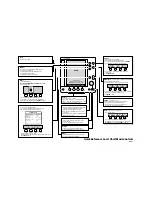
14
7. Adjust the transducer assembly vertically, until the seam on the leading edge of the
transducer (the edge closest to the transom of the boat) is level and just slightly
below the hull (see the illustration
Adjusting the Transducer Mounting Position
).
NOTE:
The transducer has a natural downward slant of 4-5 degrees from leading edge
(closest to the boat transom) to trailing edge (farthest away from the boat). Looking at the
back of the transducer, the seam should be slightly below the bottom of the hull.
8. Continue to adjust until the bracket is also level from port to starboard
(horizontally level as you look at the transducer from behind the boat (see the
illustration
Leveling the Mounting Assembly Horizontally
).
9. Mark the correct position on the transom by tracing the silhouette of the
transducer mounting bracket with a pencil or marker.
10. Tighten the pivot bolt, using the pivot screw and nut to lock the assembly.
Hand
tighten only!
11. Snap open the assembly and hand-tighten the two mounting screws, then snap
the assembly closed.
NOTE:
You will drill the third mounting hole and finalize the installation after you route the
cable and test and finish the installation in the following procedures.
4. Routing the Cable
The transducer cable has a low profile connector, which must be routed to the point
where the control head is mounted. There are several ways to route the transducer
cable to the area where the control head is installed. The most common procedure
routes the cable through the transom into the boat.
NOTE:
Your boat may have a pre-existing wiring channel or conduit that you can use for
the transducer cable.
Adjusting the Transducer
Mounting Position
Seam aligned
with boat hull
Leveling the Mounting
Assembly Horizontally
Level
Le
ve
l































